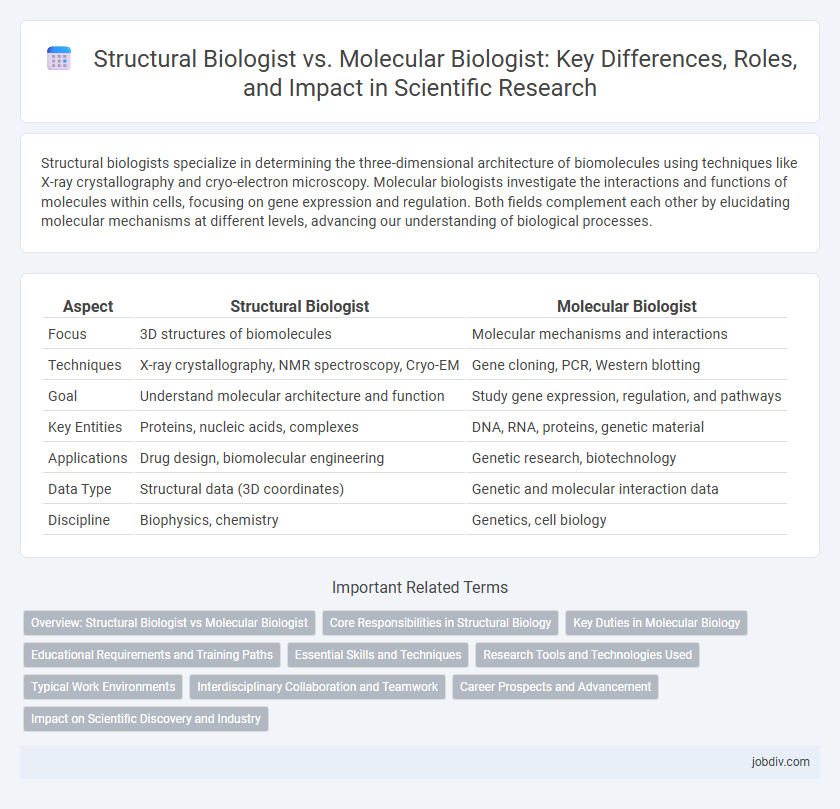Structural biologists specialize in determining the three-dimensional architecture of biomolecules using techniques like X-ray crystallography and cryo-electron microscopy. Molecular biologists investigate the interactions and functions of molecules within cells, focusing on gene expression and regulation. Both fields complement each other by elucidating molecular mechanisms at different levels, advancing our understanding of biological processes.
Table of Comparison
| Aspect | Structural Biologist | Molecular Biologist |
|---|---|---|
| Focus | 3D structures of biomolecules | Molecular mechanisms and interactions |
| Techniques | X-ray crystallography, NMR spectroscopy, Cryo-EM | Gene cloning, PCR, Western blotting |
| Goal | Understand molecular architecture and function | Study gene expression, regulation, and pathways |
| Key Entities | Proteins, nucleic acids, complexes | DNA, RNA, proteins, genetic material |
| Applications | Drug design, biomolecular engineering | Genetic research, biotechnology |
| Data Type | Structural data (3D coordinates) | Genetic and molecular interaction data |
| Discipline | Biophysics, chemistry | Genetics, cell biology |
Overview: Structural Biologist vs Molecular Biologist
Structural biologists examine the 3D architecture of biomolecules using techniques like X-ray crystallography, NMR spectroscopy, and cryo-electron microscopy to understand molecular function. Molecular biologists investigate the interactions and regulation of genes and proteins at the cellular and molecular level, often employing methods such as PCR, gel electrophoresis, and gene cloning. Both fields contribute critical insights into biological processes but differ in scale and methodological focus, with structural biology emphasizing spatial conformation and molecular biology concentrating on genetic and biochemical pathways.
Core Responsibilities in Structural Biology
Structural biologists specialize in elucidating the three-dimensional architecture of biological macromolecules using techniques such as X-ray crystallography, cryo-electron microscopy, and nuclear magnetic resonance spectroscopy. Their core responsibilities involve determining molecular conformations and interactions to understand protein folding, complex formation, and functional mechanisms at the atomic level. This detailed structural knowledge enables insights into molecular function, drug design, and the basis of diseases.
Key Duties in Molecular Biology
Molecular biologists primarily investigate the structure, function, and interactions of cellular molecules such as DNA, RNA, and proteins to understand genetic expression and regulation. They employ techniques like PCR, gel electrophoresis, and gene cloning to analyze molecular mechanisms underlying cellular processes. Their key duties include gene sequencing, mutagenesis studies, and molecular pathway analysis critical for advances in genetics, biotechnology, and medicine.
Educational Requirements and Training Paths
Structural biologists typically pursue advanced degrees such as a Ph.D. in biophysics, structural biology, or related fields, emphasizing training in techniques like X-ray crystallography, cryo-electron microscopy, and NMR spectroscopy to study macromolecular structures. Molecular biologists often obtain a bachelor's or master's degree in molecular biology, biotechnology, or genetics, with extensive laboratory training in DNA/RNA manipulation, gene expression analysis, and protein function assays. Both disciplines require rigorous education in biochemistry and cell biology, but structural biology demands specialized expertise in physical methods for atomic-level structural determination.
Essential Skills and Techniques
Structural biologists excel in techniques such as X-ray crystallography, cryo-electron microscopy, and NMR spectroscopy to determine the three-dimensional structures of macromolecules at atomic resolution. Molecular biologists specialize in skills like DNA/RNA manipulation, PCR, gel electrophoresis, and gene cloning to study gene function and expression. Both fields require proficiency in bioinformatics and data analysis, but structural biology demands a deeper understanding of physical chemistry and crystallography principles.
Research Tools and Technologies Used
Structural biologists primarily utilize X-ray crystallography, cryo-electron microscopy, and nuclear magnetic resonance spectroscopy to determine the three-dimensional structures of biomolecules at atomic resolution. Molecular biologists employ techniques such as polymerase chain reaction (PCR), gel electrophoresis, and DNA sequencing to analyze gene expression, DNA mutations, and molecular interactions. Both fields integrate computational modeling and bioinformatics tools to complement experimental data and enhance understanding of molecular functions.
Typical Work Environments
Structural biologists primarily work in laboratories equipped with advanced imaging technologies such as X-ray crystallography, cryo-electron microscopy, and NMR spectroscopy facilities to investigate the three-dimensional structures of biomolecules. Molecular biologists are often found in research institutions and biotechnology companies, utilizing PCR machines, gene sequencers, and cell culture labs to study the molecular mechanisms underlying cellular processes. Both fields collaborate closely in interdisciplinary environments, including university research centers and pharmaceutical development companies, to translate molecular insights into therapeutic applications.
Interdisciplinary Collaboration and Teamwork
Structural biologists and molecular biologists collaborate closely by integrating techniques such as X-ray crystallography and gene expression analysis to elucidate biomolecular functions at multiple scales. Their teamwork enhances understanding of protein dynamics, enabling advancements in drug design and genetic engineering. Effective interdisciplinary collaboration accelerates scientific discoveries by combining structural insights with molecular mechanisms.
Career Prospects and Advancement
Structural biologists leverage techniques such as X-ray crystallography and cryo-electron microscopy to elucidate macromolecular architectures, positioning them for roles in pharmaceutical research and biotechnology sectors where drug design and protein engineering are paramount. Molecular biologists focus on gene expression, DNA/RNA manipulation, and cellular pathways, opening career avenues in genetic engineering, clinical research, and personalized medicine development. Career advancement in structural biology often involves specialization in computational modeling or biophysical methods, while molecular biologists progress through expertise in genomics, transcriptomics, and CRISPR technologies.
Impact on Scientific Discovery and Industry
Structural biologists elucidate the three-dimensional arrangements of biomolecules, enabling precise drug design and advancing targeted therapies, which profoundly impact pharmaceutical development and biotechnology industries. Molecular biologists investigate gene expression and molecular mechanisms, driving innovations in genetic engineering, disease diagnostics, and synthetic biology applications. Their complementary expertise accelerates scientific discovery by bridging molecular function with structural insight, fueling breakthroughs in medicine and industrial biotechnology.
Structural Biologist vs Molecular Biologist Infographic

 jobdiv.com
jobdiv.com